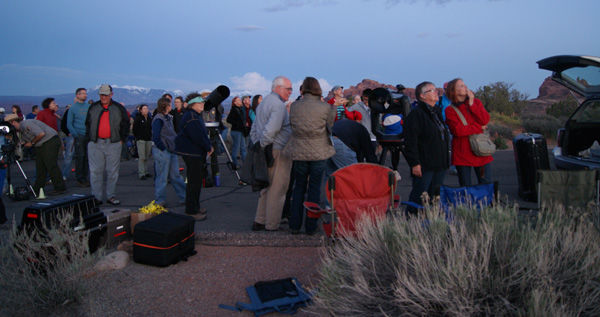Rangers and local astronomers are journeying into the cosmos on Saturday, May 5, at Arches National Park with park visitors, stopping along the way to discuss constellations, planets and dark sky conservation efforts in Moab.
The Cinco de Mayo Star Party begins at 9 p.m. at the visitor center with a presentation led by National Park Service (NPS) Ranger Michael Matthes. To honor the Mexican holiday and celebrate Latin American culture, Matthes’ presentation focuses on the late Mexican astronomer Guillermo Haro.
Although Arches National Park is not yet certified as an official Dark Sky Park, Matthes said the clear skies above Arches National Park are still an impressive place to stargaze.
“We’re lucky to have such a naturally dark sky here and in the Moab area,” Matthes said.
Following Mattes’ presentation, park ranger Alice de Anguera is taking stargazers on a “constellation tour.”
“I’ll highlight some of the best things to see this time of year, such as galaxies and star clusters,” de Anguera said.
International constellation names will be explained as de Anguera tells stories associated with the stars, like with the constellation “corus,” referred to as the “crow” by the Greeks, but known as “scorpion” by the Aztecs.
Stargazers will have at least an hour to view the sky through a half-dozen or so telescopes that will be on site. While tourists are always welcome, NPS is hoping that locals will also come to this event, said Joette Langianese, executive director of Friends of Arches and Canyonlands Parks.
“We want people to see what a beautiful night sky we have and how good the park rangers are at interpreting the night sky,” she said.
Langianese said they hope to get the community engaged in the efforts to certify Arches National Park as a Dark Sky Park by 2019. Proposed changes at the park’s Panorama Point would turn it into a Dark Sky venue where telescopes can be set up more easily.
“We have a super, high-quality dark sky,” Matthes said, “but we do get some light pollution from Moab.”
Moab Dark Skies is a group focusing on sky conservation and teaching people about light pollution. Often inviting the public to star events, 50 government officials were invited to a similar star party in April, where the importance of the dark skies in Moab was explained.
Crystal White, one of the founding members of Moab Dark Skies, said it’s important for people to be able to see the night sky.
“We really want people to think about their place in this universe,” she said. “If you live in a city under orange skies, you’re less likely to think about that, and the whole idea of dark sky conservation doesn’t really make sense because you’re not familiar with stars. When you get out, underneath a truly dark sky, you can see thousands of stars and planets and the Milky Way stretching across the night sky.”
The dark skies in the area are a draw for tourists, White said, some of whom come from larger cities outside of Utah to be able to stargaze.
This is Arches National Park’s fourth year collaborating with nearby Canyonlands National Park and Dead Horse Point State Park, both of which are designated dark sky parks, to present interpretive night sky programs for the public.
Ashley Bunton contributed to this report.
DID YOU KNOW?
Zodiacal light is a phenomenon that people in Moab can sometimes see about an hour after sunset in the spring and fall, according to Moab Dark Skies co-founder Crystal White.
“You’ll see this giant triangle of light come up,” White said. “There are bits of matter from the formation of our solar system, like dust, out in space still, floating around, and the sunlight will reflect off of that dust.”
Turn your gaze to the Western sky for a glimpse of zodiacal light in the spring.
Starry-eyed astronomers gather at Arches National Park
When: Saturday, May 5, 9-11 p.m.
Where: Arches National Park Visitor Center
Cost: Free
Information: nps.gov/arch/index.htm or 435-719-2244
How: Arrive early to ensure a parking spot at the visitor center. NPS recommends that visitors bring warm clothing, and flash lights or headlamps with a red setting. Most headlamps come with a red light setting because bright white light can impair night vision.
“We want people to see what a beautiful night sky we have and how good the park rangers are at interpreting the night sky.”




